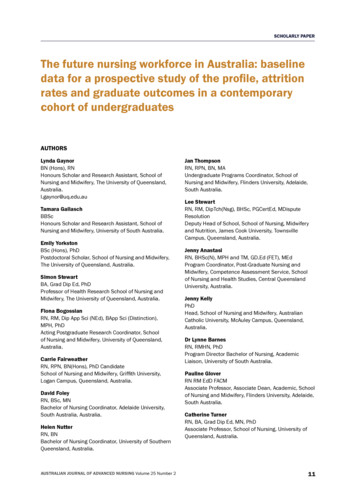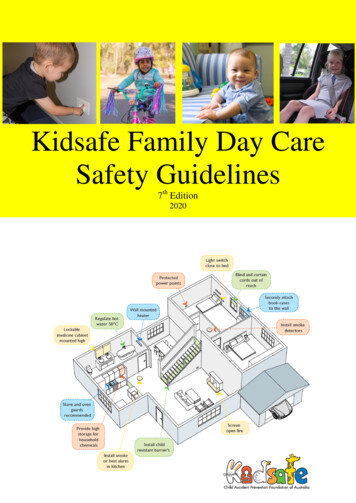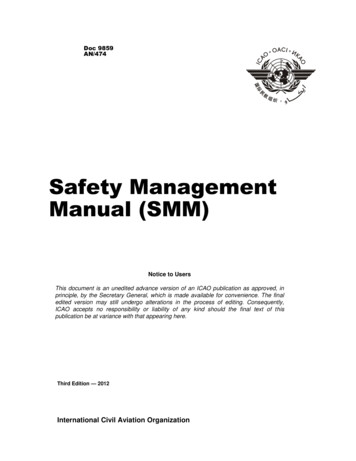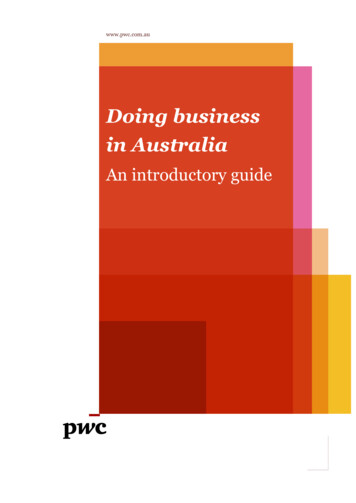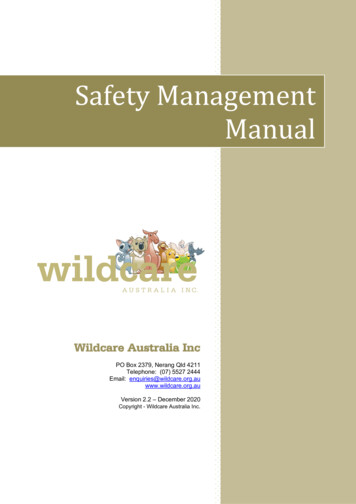
Transcription
Safety ManagementManualWildcare Australia IncPO Box 2379, Nerang Qld 4211Telephone: (07) 5527 2444Email: n 2.2 – December 2020Copyright - Wildcare Australia Inc.
Safety Management ManualTABLE OF CONTENTS1. Occupational Health and Safety Policy . 42. General Safety Management . 52.1QUALIFICATIONS AND COMPETENCE52.2SAFETY MANAGEMENT RESPONSIBILITIES62.3WILDCARE WORK SYSTEMS AND PERSONAL PROTECTIVE CLOTHING72.4HAZARD IDENTIFICATION, RISK ASSESSMENT & MANAGEMENT72.5CONSULTATIVE ARRANGEMENTS92.6PROJECTS REQUIRING HIGHER LEVEL RISK MANAGEMENT92.7EMERGENCY RESPONSE PLANNING102.8DISCLOSURE OF PRE-EXISTING INJURIES OR MEDICAL CONDITIONS112.9BULLYING AND HARASSMENT112.10LONE WORKERS123. Work Site Safety . 143.1WILDlife RESCUE AND HANDLING143.2WORK SITE SAFETY143.3SUITABLE ATTIRE153.4ROSS RIVER FEVER AND OTHER VECTOR-BOURNE DISEASES163.5BUSHFIRE SAFETY163.6HANDLING NEEDLES, SYRINGES AND OTHER SHARP OBJECTS173.7FOOD PREPARATION AND FOOD SAFETY173.8WORK SITE HYGIENE183.9MANUAL HANDLING223.10EXTREME WEATHER CONDITIONS233.11TRAVEL BY BOAT – USE OF BOATS243.12FATIGUE254. Motor Vehicle and Road Safety. 264.1GENERAL DRIVER RESPONSIBILITY264.2ROAD SAFETY AND VEHICLE MAINTENANCE264.3USE OF MOBILE PHONES IN VEHICLES275. First Aid . 285.1FIRST AID285.2FIRST AID: MEDICATIONS295.3FIRST AID: INFECTION CONTROL306. Activity Records and Reporting. 326.1INJURY/INCIDENT REPORTING PROCEDURES326.2PROJECT ACTIVITY RECORDS ANd REPORTS326.3INJURY/INCIDENT REPORTING PROCEDURES32Safety Management ManualWildcare Australia Inc.2
7. Tools and Appliances . 347.1SAFETY WITH HAND TOOLS348. Specific Activities . 358.1GENERAL358.2WILDLIFE RESCUES358.3VEGETATION COLLECTION358.4USE OF LADDERS378.5WORKING AT HEIGHTS378.6ENTANGLEMENT – NETTING AND BARBED WIRE378.7CHEMICALS AND DANGEROUS SUBSTANCES388.8HANDLING DECEASED ANIMALS (CARCASSES)388.9FIREARMS398.10TRANSPORTING WILDLIFE408.11ATTENDING RESCUES AT NIGHT418.12WORKING ON OR NEAR ROADS428.13WORKING IN CONFINED SPACES438.14WORKING IN WATER BODIES438.15WORKING WITH SNAKES439. Attachments. 46Safety Management ManualWildcare Australia Inc.3
1. Occupational Health and Safety PolicyWILDCARE (Wildcare Australia Inc) was formed in 1993 to provide a rescue and rehabilitation service to localwildlife, to provide training to wildlife volunteers and to promote the protection of wildlife within the community.WILDCARE volunteers rescue over 6,000 animals each year in the South-east Queensland region and as such,provide an important service to our wildlife and the community.With over 1700 members, WILDCARE has identified that it needs to have a WILDCARE plan of safetymanagement for our valued volunteers and the community we serve. WILDCARE as an organisation iscommitted to upholding a high standard of safety in all areas of our operations through this – our new SafetyManagement Manual. This Manual will operate in conjunction with the WILDCARE Volunteer Manual andRescue and First Aid for Wildlife training manual.The goal of WILDCARE’s Safety Management Manual is to protect the health and safety of its volunteers andthe community whilst conducting our activities. Health and Safety is the responsibility of all volunteers.We will do this by: Providing and maintaining healthy and safe work areas. Providing information about the safety equipment and personal protective equipment (PPE) required. Providing information, instruction, training and supervision to ensure the safety of all volunteers. Requiring all volunteers to adhere strictly to all safety policies, regulations, codes of practices andprocedures. Developing and maintaining emergency procedures, which, in the event of an incident, minimiseharmful effects. Requiring all WILDCARE volunteers to report hazards (or hazardous practices) to the ManagementCommittee. This information will be passed to the Safety Officer. Requiring all volunteers to accept that safe work practice is the responsibility of every person takingpart in WILDCARE’s activities. Communicating safety information and encouraging participation of volunteers in safety matters.The cornerstone of effective safety management is the commitment of all volunteers to achieving safety goals– it is a team effort. We invite all volunteers to make their own commitment to the achievement of our goals bybecoming involved in safety management.Remember, YOU are responsible for your safety andthe safety of those potentially affected by your actions.Wildcare Australia Inc.Management CommitteeSafety Management ManualWildcare Australia Inc.4
2. General Safety ManagementThe Safety Management document is to be used to supplement the information provided to volunteers in thefollowing: WILDCARE Volunteer Manual WILDCARE Rescue and First Aid for Wildlife training manual WILDCARE website – www.wildcare.org.au WILDCARE species-specific training workshops and manuals WILDCARE communications (e.g. emails and newsletters) WILDCARE Policies and Guidelines Code of Practice – Care of Sick, Injured or Orphaned Protected Animals in Queensland under theNature Conservation Act 1992 as issued by the Department of Environment and Science (DES).Information about conducting rescues, animal handling and all other resources have been designed tomaximise the safety of our volunteers, members of the public and the welfare of the animals.In particular volunteers should note the Section “Wildlife Rescue” as contained in the WILDCARERescue and First Aid for Wildlife manual.The WILDCARE Safety Management Manual is based on the guidelines provided by the ‘In Safe Hands Toolkit’(3rd Edition) published by Conservation Volunteers Australia.WILDCARE commits to preventing workplace accidents, eliminating dangerous occurrences and willstrive to achieve a zero-accident rate.2.1 QUALIFICATIONS AND COMPETENCE2.1.1QualificationsThe Management Committee members and Team Leaders will have attained the following qualifications/training: Training safety covering WILDCARE Safety Management Manual policies and procedures; and Risk Assessment - training conducted by the Safety Officer or someone with equivalent safetyqualifications.The Management Committee positions are outlined in the current Rules of Association (Constitution).The Safety Officer preferably has experience in work, health and safety such as a recognised qualification inSafety Management or Work, Health and Safety to at least a Certificate 2 standard, or recognised qualificationin safety management. (Note: Although preferable an appointment of a Safety Officer is not mandatory underWHS (Workplace Health and Safety) law for volunteer organisations.)2.1.2Technical Skills and CompetenceThe Management Committee and Team Leaders must maintain a sound understanding of the practical taskscompleted by the organisation, the associated risks and how these are managed.The technical skills and competence required for volunteers are outlined in the WILDCARE Rescue and FirstAid for Wildlife training manual along with training courses provided by WILDCARE.It is critical that all volunteers adhere to the guidance material and training provided by WILDCARE to ensuretasks are completed safely.Safety Management ManualWildcare Australia Inc.5
2.2 SAFETY MANAGEMENT RESPONSIBILITIES2.2.1DefinitionsActivity – any task where the volunteer represents WILDCARE, e.g. a rescue, transporting wildlife, aneducation event, public display, etc.Team Leader – a person who has been elected to act in a particular role to assist WILDCARE to achieve itsaims and objectives or assist the Management Committee to complete tasks. This includes TraumaCarers, Species Coordinators, Community Liaison Coordinators, Media Coordinator, Workshop Trainersand other positions as appointed by the WILDCARE Management Committee from time to time.2.2.2ResponsibilitiesEvery WILDCARE volunteer has a responsibility for the creation and maintenance of a safe workingenvironment.The Management Committee – has the responsibility of setting safety policy and procedure to provide a ‘dutyof care’ of all participants of any activity conducted by WILDCARE. The Management Committee will monitorthe activities of Team Leaders to ensure they are competent at implementing and monitoring the safety ofactivities.It is the responsibility of Management Committee Members and Team Leaders to ensure that: They notify the Management Committee and Safety Officer of all dangerous occurrences; They are aware and understand the principles of incident and accident reporting and investigation; All incidents and accidents that result in, or have the potential to result in, injury or damage areinvestigated and where necessary, corrective or preventative action is taken; All matters relating to volunteer welfare are dealt with in the most appropriate and timely manner.Team Leaders – may be responsible for the planning and delivery of practical activities, associated safetyprocesses and the onsite supervision of all volunteers.Note: Each Management Committee member and Team Leader has the authority over their roles andresponsibilities. No other member may interfere with their roles in such a manner that will negatively affect thesafety of their activities.Safety Officer: It is the responsibility of the Safety Officer to: Assist or conduct risk assessments; Assist at sites in identifying the causes, or potential causes, of dangerous occurrences and accidentsand develop corrective action; Ensure state authorities are appropriately notified of all reportable occurrences or events; Updating the risk register; and Distributing safety information and advice.Organisation volunteers must: Declare pre-existing injuries or medical conditions that may affect their participation in an activity theyhave nominated for; Declare if they have any illness or fatigue that may affect their safe performance of any activity;including rescues; Notify the Team Leader should they become unwell or fatigued during an activity; Co-operate with any reasonable policy or procedure relating to health or safety and to animal welfarethat has been notified to volunteers, including adherence to instructions and procedures in WILDCAREdocuments; Report any unsafe situation or practice to their Team Leader, Safety Officer or a member of theManagement Committee;Safety Management ManualWildcare Australia Inc.6
Report any injury or accident as soon as possible and before leaving a project or activity site to theTeam Leader, or a Management Committee Member if a Team Leader is not present; Take reasonable care and precautions for his or her own health and safety; Take reasonable care that his or her acts or omissions do not adversely affect the health and safety ofother persons; Comply, so far as the volunteer is reasonably able, with any reasonable instruction that is given by theTeam Leader to allow the person to comply with this safety management process; Vaccinated volunteers involved with direct handling of bats are responsible for keeping theirvaccinations and titre results up to date; and Ensure their emergency contact details are notified to the WILDCARE Secretary and kept up to date.2.3 WILDCARE WORK SYSTEMS AND PERSONAL PROTECTIVE CLOTHINGWILDCARE has a duty of care to protect volunteers from workplace hazards including injuries while handlingwildlife, harmful UV radiation, insect, spider and snakebites, chemical contamination and tool use injuries.Work Health and Safety legislation also requires that volunteers must cooperate with WILDCARE.All volunteers will be encouraged to provide and wear their own Personal Protective Equipment (PPE) includingappropriate clothing based on the task being undertaken. Details of the required clothing and PPE are providedin the WILDCARE Rescue and First Aid for Wildlife training manual and other species-specific training manuals.All items of PPE utilised must be in good working condition, be maintained by the volunteer and the user mustfollow the instructions provided (if any) on its use.2.4 HAZARD IDENTIFICATION, RISK ASSESSMENT & MANAGEMENT2.4.1OverviewWILDCARE as an organisation has a commitment to health and safety to our volunteers and the community inall areas in which we operate. To maximise safety for WILDCARE volunteers and the community, a HazardIdentification and Risk Assessment and Management Process (RAMP) will be undertaken on all activities.Identifying hazards and risks is an important first step to adopting a risk management approach.Hazard: Hazard – an object, situation or activity that has the potential to cause harm.Risk: The possible harmful effects from interacting with the hazard.WILDCARE uses standard techniques for identifying hazards. Hazard identification utilises both pro-active andre-active techniques from a variety of sources, these include but are not limited to: Reports from WILDCARE volunteers; the investigation and follow-up of reported hazards and incidents; Safety meetings and safety audits; and Information exchange with other industry groups.It is important that the Management Committee, Team Leaders and volunteers remain vigilant for new oremerging hazards.The current WILDCARE Safety Officer is aiming to complete a risk assessment for all current WILDCAREactivities. Based on this and input from the Management Committee, Team Leaders and eventually allvolunteers, a Hazard and Risk Register will be developed and kept up to date with any changes or new hazards.The goal is for a RAMP to be provided for each activity so that the hazards will be identified to all WILDCAREvolunteers and all risk control measures documented and explained.Safety Management ManualWildcare Australia Inc.7
For example, a rescue activity may include the following hazards and associated risks: Working with high-risk species of wildlife including bats, snakes, large reptiles, adult macropods andkoalas, risk of Australian Bat Lyssavirus (ABLV), bites, scratches and injuries; Falls; Traffic; Power lines; Working alone; Driving; Snake bite when in the field; Use of rescue equipment; and Injury to members of the public.A RAMP will be used to identify and minimise the risk associated with these hazards.In addition to existing activities, a RAMP will be triggered by: Changing work practices, procedures and the work environment; Introducing new equipment; New information about the risks become available; Responding to workplace incidents even if they have not caused an injury; Responding to the concerns of volunteers and others in the workplace; and Requirement by WHS regulations for specific hazards.For jobs where a risk matrix has been completed, there is no need to repeat the assessment unless there hasbeen a change in circumstances.2.4.2Hazard and Risk RegisterWILDCARE will maintain a Hazard and Risk Register as part of the Risk Management process. This will bemaintained initially in an Excel Database format for different activities and can be printed for use or review. Itwill ensure that hazards are tracked and treated as part of a formal process of prioritisation, documentation andassessment.It will be maintained by the Safety Officer position and a copy will be available to the WILDCARE ManagementCommittee and Team Leaders.Printed copies will be provided as required for each individual or group activity.2.4.3Risk Assessment and Management Process (RAMP)Risk Assessment and Management Process is a formal process that is used to: identify hazards associated with an organisation’s operations; analyse and assess the risks associated with those hazards; implement controls, to militate against future accidents or incidents; and the hazards and risk are continuously updated to reflect learning from incidents and change.The main elements of the risk management process, based upon AS/NZS 4360 (2004), are detailed at ANNEX1 – RISK ASSESSMENT AND MANAGEMENT PROCESS.Safety Management ManualWildcare Australia Inc.8
2.4.4Unacceptable RiskWhere the risk assessment process leaves the Management Committee or Team Leaders in any doubt that theactivity/rescue can proceed safely, they should suspend work on the project, or that component, which is thesource of concern, until such time as the risk can be satisfactorily controlled. At no time should the achievementof work outcomes be allowed to compromise safety.2.4.5DocumentationOnce a risk assessment is completed, it must be signed-off by the Safety Officer, Team Leader or ManagementCommittee member in the case of projects, indicating that they are satisfied that the assessment has beenproperly performed and the risk has been treated and/or mitigated.The risk assessment process will be documented by the Safety Officer in the WILDCARE Risk Register and thedocumentation must be retained as long as the risk assessment remains valid.2.5 CONSULTATIVE ARRANGEMENTS2.5.1Health and Safety RepresentativesWILDCARE has a volunteer Safety Officer position (as per 2.1.1) for the purpose of reviewing safetyperformance, disseminating safety information, assisting in addressing and representing volunteers on safetyissues raised by volunteers.2.5.2Safety MeetingsSafety meetings will be held as part of the WILDCARE General Meetings which are scheduled periodicallyand/or the WILDCARE Annual General Meeting which is scheduled every year. It will provide a forum fordiscussion on how safety is managed and address any issues raised.It will be a standing agenda item at General Meetings and AGM to discuss safety management, audit results,risk assessments and incidents.Other relevant safety information and communications will be distributed by the Safety Officer or ManagementCommittee with the approval of at least two Management Committee members, via email, newsletters, websiteor training days as applicable.2.6 PROJECTS REQUIRING HIGHER LEVEL RISK MANAGEMENT2.6.1Justification for Higher Risk ProjectsIf WILDCARE is to voluntarily undertake an activity that involves a higher than normal level of risk, there shouldbe sound reason for doing so, and only then, if the extra risk can be satisfactorily managed.Factors that would cause a project to fall into this category include: Remote location and/or travel; Reasonable possibility of extreme climatic and associated conditions e.g. blizzard, cyclone, flood,extreme heat, bush fire; Use of firearms; Use of drugs to sedate and euthanize wildlife; Proximity of heavy vehicles or machinery; Possibility of exposure to dangerous substances such as herbicides, lead based paint or asbestos; and Any risk that requires the use of PPE that would not normally be available on project sites, or otherspecialised safety equipment e.g. fall arrest harnesses or scaffolding, respirators, disposable overalls.All activities undertaken on High Risk Projects need to be approved by the Management Committee prior tocommencement in conjunction with the Safety Officer (if there is a position holder).Safety Management ManualWildcare Australia Inc.9
2.7 EMERGENCY RESPONSE PLANNING2.7.1Group ActivitiesFor a group activity the Team Leader leading the activity will brief the participants, as part of the on-site activity,an emergency response and evacuation plan that is communicated to all persons working at that site.Consideration must be given to reasonably foreseeable emergencies so that appropriate response plans aredeveloped. The plan needs to identify strategies for both getting assistance to the team and evacuating theteam to a safer location.2.7.2Project SitesA good Emergency Response includes: Reasonable access to two forms of communication (so far as is practicable); The position where the communication signal is strongest should be determined and then marked; The vehicle should be parked in a position where it is immediately available for evacuation and shouldhave sufficient fuel to reach the nearest hospital or point of emergency assistance; The Team Leader must identify a suitable emergency signal such as a whistle or vehicle horn blast; Alternative escape routes need to be identified in recognition that the preferred route might not be safeor available e.g. bushfire, flood, storm; Concise unambiguous directions to the site (including where appropriate, map references or referencesto readily identifiable landmarks) must be recorded and in a location where they are accessible to allparticipants; Any participants with first aid qualifications or experience should be identified so they can assist withthe treatment of injuries, or in the communication with emergency services; and Consideration must also be given to the possibility that the Team Leader may be incapacitated andunable to initiate or lead the emergency response.At the first practicable opportunity, after participants have been made safe and emergency services alerted, theTeam Leader should advise the President or Vice-President who will take appropriate action.2.7.3Emergency Communication ProtocolsThe purpose of communications should be to arrange assistance for volunteers as quickly and effectively aspossible so as to minimise harmful effects to individuals. It is essential that Team Leaders have all necessaryemergency contact details.Emergency contact details for volunteers are recorded by the WILDCARE Secretary in the membershipdatabase. In the event of an emergency involving a volunteer, the Team Leader may obtain their relevantEmergency Contact details by calling a WILDCARE Management Committee member. The ManagementCommittee members are able to access the membership records and contact details.NOTE: The national ‘000’ emergency number should be backed up with local emergency servicenumbers and the ‘112’ emergency number for mobile phones.No volunteer should offer, or be drawn into, any media comment in respect of an emergency, unless specificallyauthorised by the WILDCARE President or Vice-President.A polite “No comment” is all that should be offered, and the enquiry directed to the President, Vice-President orMedia Coordinator.2.7.4Emergency InformationTeam Leaders and all volunteers involved in activities should review emergency services and the weatherbureau websites and applications as applicable to obtain useful information in planning and monitoring activities.Safety Management ManualWildcare Australia Inc.10
2.8 DISCLOSURE OF PRE-EXISTING INJURIES OR MEDICAL CONDITIONS2.8.1Consideration for activitiesThe safety of a work site or work practice cannot be assessed without consideration of the capacity of thepersons involved. All volunteers must declare pre-existing injuries, medical conditions or concerns that mayaffect their participation (as per 2.2.2).An activity that is safe for one person may be unsafe, even dangerous, for another person who has a preexisting injury or medical condition. Consequently, volunteers must have their foreseeable tasks and work sitesclearly explained to them so they are able to make a properly informed and considered decision about whetheror not they are capable of conducting the task.It is important that volunteers consider their own injuries, illness, fatigue, personal limitations or medicalconditions before undertaking activities and advise if they feel they may not be able to complete an activitysafely. Another more suitable activity may be assigned if applicable.Any personal information disclosed to WILDCARE, must be treated in strict confidence and used only for thepurpose of safely and discreetly managing the condition disclosed. Information regarding medical conditionswill not be recorded or maintained by WILDCARE and it is important that volunteers take responsibility for theirown restrictions.2.9 BULLYING AND HARASSMENTEveryone is entitled to a positive workplace free from intimidation, ridicule and harassment. Every person hasa responsibility to maintain that environment in WILDCARE. Bullying behaviour is based on the misuse of powerin human relationships and negates the dignity and autonomy of its victims. There are bound to be occasionaldifferences of opinion, conflicts and problems in every organisation. Only when the treatment of another personis unreasonable, offensive or harmful does organisational bullying exist. Bullying and harassment will not betolerated.WILDCARE will have in place the following procedure: A contact person to receive complaints - this will be the Safety Officer or another representative that hasbeen elected by the WILDCARE Management Committee; A process to resolve complaints respectfully, confidentially and fairly will be decided by the ManagementCommittee in consultation with Safety Officer position holder (if the position is filled). This may require aformal mediation process; and Measures to provide everyone with information on what constitutes workplace bullying and harassment.The Committee may revoke a membership should bullying or harassment behaviour continue if a volunteer hasbeen counselled about their behaviour and does not cease the behaviour. If this occurs, the volunteer will notbe able to regain membership.2.9.1Definitions of Bullying and HarassmentThe following definition is based on information provided by Workplace Health and Safety Queensland (17 March2014)Workplace harassment/bullying: is where a person is subjected to behaviour that: is repeated, unwelcome and unsolicited; the person considers to be offensive, intimidating, humiliating or threatening; and/or a reasonable person would consider to be offensive, humiliating, intimidating or threatening.Safety Management ManualWildcare Australia Inc.11
Workplace harassment/bullying covers a wide range of behaviours ranging from subtle intimidation to moreobvious aggressive tactics, including: abusing a person loudly, usually when others are present; constant ridicule and being put down; sending/leaving offensive messages on email or the telephone; sabotaging a person's activities, for example, by deliberately withholding or supplying incorrectinformation, hiding documents or equipment or not passing on messages; humiliating a person through gestures, sarcasm, criticism and insults, often in front of other WILDCAREmembers, other organisations, or members of the public; and/or spreading gossip or false, malicious rumours about a person with an intent to cause the person harm.What is not workplace harassment? a single incident of harassing type behaviour; reasonable management action taken in a reasonable way; and/or acts of unlawful discrimination, vilification or sexual harassment.Acts of unlawful discrimination, vilification or sexual harassment are addressed under the ‘Queensland AntiDiscrimination Act 1991’.2.10 LONE WORKERSWorking alone, particularly in field-based situations or on rescue call outs, increases the potential consequencesof hazards due to the difficulty in obtaining emergency assistance and the potential for injury, illness orbreakdown to go unnoticed for some time.The consequences can be potentially fatal, so it is essential that the following protocols are in placeand are followed in the management of risk and communication with the lone worker.2.10.1 General PrinciplesA person is deemed to be working alone when they cannot be seen or heard by another person, and when theycannot expect a visit from another volunteer or member of the public for some time. (This includes going out tomeet unknown members of the public in isolated locations, to isolated locations for rescues where there is nomobile phone coverage or releasing wildlife in a remote location). All volunteers will be required to provideemergency contact details. These will be recorded in the membership database.Lone worker principles: No worker should engage in isolated work if they have a medical condition that is deemed to bepotentially life threatening. High-risk activities must not be undertaken by lone workers. It is recommended that the lone worker have a first aid qualification or experience. Emergency contact numbers must be held for the lone worker. Lone workers must be reminded of the need for compliance with the organisation’s safety policy at alltimes e.g. avoidance of risk, the wearing of PPE. Lone workers should know where they are at all times so that they can accurately relay their position toemergency services if the need arose. A lone worker MUST:a. Inform a family member, friend (if practical) or WILDCARE Hotline volunteer that they are attendinga rescue, giving detailed location details (including the address they are attending, directions wherethey will be headed if walking a distance from their vehicle/initial rescue address, contact details forthe person that they are to meet).Safety Management ManualWildcare Australia Inc.12
b. Telephone the family member, friend or WILDCARE Hotline volunteer on arrival at a remote or lonerescue, or the closest point where mobile coverage is available.c. Telephone the family member, friend or WILDCARE Hotline volunteer at completion of lone rescue.d. If the WILDCARE Hotline is not manned, then contact should be made with a Team Leader or otherresponsible member/friend.e. Ensure that they have a good quality and charged torch with them if they are to be working aloneat night. It is recommen
Requiring all volunteers to accept that safe work practice is the responsibility of every person taking part in WILDCARE's activities. Communicating safety information and encouraging participation of volunteers in safety matters. The cornerstone of effective safety management is the commitment of all volunteers to achieving safety goals
